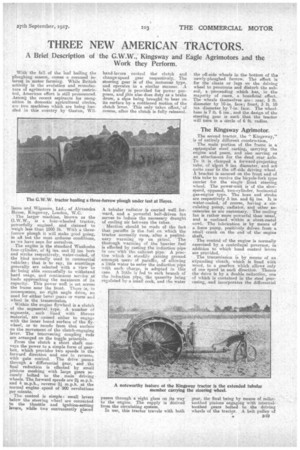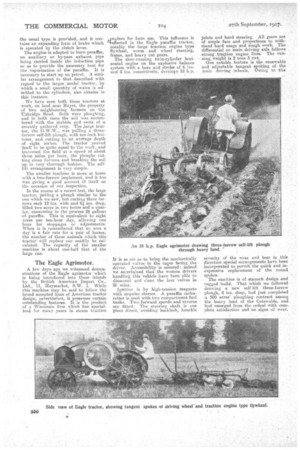THREE NEW AMERICAN TRACTORS.
Page 15

Page 16

If you've noticed an error in this article please click here to report it so we can fix it.
A Brief Description of the G.W.W., Kingsway and Eagle Agrimotors and the Work they Perform.
"With the fall of the leaf hailing the ploughing season, comes a resumed interest in motor farming. While British activity in the evolution and manufacture of agrimotors is necessarily restricted, American effort is still pronounced. Aanong the recent aspirants for recognition in domestic agricultural circles, are two machines which are being handled in this country by Gaston, Wil
Barna and Wig-more, Ltd., a Alexandra House, Kingsway, London W.C. The larger machine, known as the G.W.W.., is a four-wheeled tractor, powerfully engined, and claimed to weigh less than 1500 lb. With a threefurrow plough it will make good going, in a'A but the most arduous conditions, as we have seen for ourselves.
The engine is the standard Waukesha four-cylinder, of 44 ins. and 5g ins. bore and stroke respectively, water-cooled, of the kind normally used in commercial vehicles; that is to say, its scantlings generally, are selected with a view to Its' being able successfidly.to withstand hard usage, and continuous service at loads approaching the maximum of its capacity. This power unit is set across the frame near the front. There is, in consequence, ne right angle drive, no need for either bevel gears or worm an wheel in the transmission.
• Within the engine flywheel is a clutch of the segmental type. A number of segments, each lined with fibrous material, are caused either to engage with the inner bored surface of the flywheel, or to recede from that surface on the movement of the clutch-engaging lever. The intervening coupling rods are arranged on the toggle principle.
From the clutch a short shaft conveys the power to a simple form of gearbox, which provides two speeds in the forward direction and one in reverse, with gate control. The drive passes through a •differential gear, and _the final reduction is effected by small pinions meshing with large gears securely bolted to the main driving wheels. The forward speeds are 4 m.p.h. and 4 m.p.h., reverse 2-1 m.p.h. at the normal engine speed of 900 revolutions per minute.
The control is simple : small levers below the steering wheel are connected to the throttle and ignition-setting levers, while two conveniently klaced hand-levers control thd clutch and change-speed gear respectively. The steering gear is of the motorcar type, and operates in a similar manner. A belt pulley is provided for power purposes, and hi also does duty as a brake drum, a shoe being brought to bear on its surface-by a continued motion of the clutch lever. This only takes effect,' of course, after the clutch is fully released.
A tubular radiator is carried well forward, and a powerful belt-driven fan serves to induce the necessary draught of cooling air between the tubes.
Mention should be made of the fact that paraffin is the. fuel on which the tractor normally runs, after a preliminary warming up on riptrol. The thorough warming of the heavier fuel is effected by casting the induction pipe in 0114) wIth the exhaust pipe. A practice which is BteaoliJy gaining ground amongst, users of paraffin, of allowing a little water to enter the induction pipe with eachcharge, is adopted in this case. A little is fed to each branch of the induction pipe, the quantity being regulated by a small cock; and the water
passes through a sight glass on its way to the engine. The supply is derived from the circulating system. In use, this tractor travels with both
the off-side wheels in the bottom of the newly-ploughed furrow. The effect is for the cleats or lugs on the driving wheel to penetrate and disturb the subsoil, a proceeding which has, in the majority of cases, a beneficial effect, The wheels themselves are: rear, 5 ft. diameter by 10-in, face; front, 3 ft. 10 ins, diameter by 7-in. face. The wheelbase is 7 ft. 6 ins., and the design of the steering gear is such that the tractor will turn in a circle of 6 ft. radius.
The Kingsway Agrimotor.
The second tractor, the "Kingsway," is of entirely different construction.
The main portion of the frame is a rectangular steel casting, carrying the engine and gears, and also serving as an attachment for the dead rear axle. To it is clamped a forward-projecting tube, of about 9 ins, diameter, and sot quite near to the off-side driving wheel. A bracket is secured on the front end of this tube to receive the bicycle-fork type carrier for the single front steering wheel. The power-unit is' of the slowspeed, opposed, two-cylinder, horizontal gas-engine type. The bore and stroke are respectively 5 ins, and 6j ins. It is water-cooled, of course, having a circulating pump, radiator, and other accessories as are customary. The cooling fan is rather more powerful than usual, and is enclosed within a sheet-metal cowl. The lubrication is by means of a force pump, positively driven from a small crank on the end of the engine shaft,
The control of the engine is normally exercised by a centrifugal governor, in addition to which hand control levers are provided.
The transmission is by means of an expanding clutch, whiCh is lined with wood, to a gearbox which allows only of one speed in each direction. Thence the drive is by a double reduction, one of which is contained in the steel gearcasing, and incorporates the differential
gear, the final being by means of rollertoothed pinions engaging with internaltoothed gears bolted to the driving wheels of the tractor. A belt pulley of the usual type is provided, and it contains an expanding form of. brake which
is operated by the clutch lever. • The engine-is adapted to burn paraffin, an auxiliary or by-pass exhaust pipe being carried inside the induction pipe so as to provide the necessary heat for the vaporization of the paraffin. It is necessary to start up -on•petrol. A similar arrangement to that described with regard to the larger .model tractor, by which a small quantity of water is admitted to the cylinders; also obtains in
this instance. • 'We have seen both these tractors at work, on land near 'Hayes, the property of two neighbouring farmers on the Uxbridge Road. Both were ploughing, and in both cases the soil ' was encumbered with the stubble and roots of a recently gathered crop. The „large tractor, the O.W.W., was pulling a threefurrow self-lift plough; with ten-inch bottoms, and cutting to an • average depth • of eight inches. The tractor proved itself to be quite equal to the work, and traversed the field at a speed of about three miles per hour, the ploughs cutting clean furrows and breaking the soil up in very thorough fashion. The selflift arrangement is very simple.
The Rmaller Machine is more at home with a two-furrow implement, and it ton was giving a good account of itself on the occasion of our inspection.
In the course of a recent test, the large tractor, pulling a plough similar to the one which we saw, but cutting three furrows each 12 ins, wide and 6i ins. deep, tilled two acres in two hours and a quarter, consuming in the process 2 gallons of paraffin. This is equivalent to eight acres per ten-hour day, allowing one hour for stoppages or adjustments. When is is remembered that an acre a day is a fair rate for a pair of horses, the number of those animals which this tractor' will replace can readily be calculated. The capacity of the smaller machine is about one-half that of the largo one.
The Eagle Agrimotor.
A few days ago we witnessed demonstrations of the Eagle agrimotor which is being introduced into these islands by the British American Import Co., Ltd., 11, Haymarket, S.W.1. While this machine may be said to *follow the broad accepted lines of American tractor design, nevertheless, it possesses certain outstanding features. It is the product of a Wiseensin firm which has specialized for many years in steam traction
.engines for farm use. This influence is 14'eflected in the Eagle paraffin tractor, notably the large traction. engine type flywheel, worm and wheel Steering,
frame, and heavy cut gears. _ The slow-running twin-cylinder horizontal engine on the explosive balance system with a bore and stroke of 6 ins. and 8 iris, respectively, cleyelops 18 h.p.
It is so set as to bring the mechanically operated valves in the cages facing the driver. Accessibility is assured: indeed we ascertained that the women drivers handling this vehicle have been able to dismount arid clean the four valves in 20 mins.
ignition is by high-tension magneto with impulse starter. A paraffin carburetter is used with two compartment fuel tanks. Two forward speeds and reverse. are fitted. The steering shaft is one piece direct, avoiding backlash, knuckle joints and hard steering. All gears are of ample face and proportions to withstand hard usage and rough work. The differential on main driving axle follows strong _traction engine lines. The running weight is 2 tons 3 cwt. One notable feature is the renewable and adjustable tangent spoking of the main driving *heels. 'Owing to 'the severity of the wear and tear in this direction special arrangements have been incorporated to permit the quick and inexpensive replacement of the round spokes. The machine is of staunch design and rugged build. That •which we followed drawing a new self-lift three-furrow plough, 8 ins, deep, had just completed a 500 acres' ploughing contract among the heavy land of the Cotswolds, and had emerged from the ordeal with complete satisfaction and no signs of wear.






















